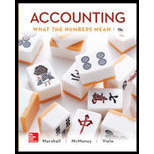
Accounting: What the Numbers Mean
11th Edition
ISBN: 9781259535314
Author: David Marshall, Wayne William McManus, Daniel Viele
Publisher: McGraw-Hill Education
expand_more
expand_more
format_list_bulleted
Question
Chapter 11, Problem 11.18C
To determine
(A)
Apart from income statement and
To determine
(B)
Describe the notes disclosures that should be provided by Gerrard construction co.
To determine
(C)
Find
Accounts receivable turnover- No. of days sales in account receivable
To determine
(D)
Find
- Debt ratio
- Debt/equity ratio
To determine
(E)
Impact of capital lease on debt and debt/equity ratio
To determine
(F)
Calculate
- Earnings per share
- Price/earnings ratio
- Dividend yield
- Dividend payout ratio
Expert Solution & Answer
Want to see the full answer?
Check out a sample textbook solution
Students have asked these similar questions
Using the results of the Top 5 Customers by Accounts Receivable Amount Due and the Top 5
Customers by Outstanding Sales Order Amount visualization, what conclusion can be made
regarding the outstanding sales orders?
a. The high value of outstanding accounts receivable for Sanders Corp may be directly
related to their high value of outstanding sales orders.
b. The high value of outstanding accounts receivable for Williams Corp may be directly
related to their high value of outstanding sales orders.
c. The high value of outstanding sales orders for Roberts Corp has caused them not to pay a
large value of invoices.
d. Evans Corp has a high value of outstanding accounts receivable and outstanding sales
orders.
Based on the dashboard, what recommendations would you give to improve the overall sales
and revenue of Borders USA?
Is there any additional information would you like to have to provide useful
recommendations?
What are your interpretations of AR Aging and Sales Order Aging dashboards?
1. Using the Sales vs Revenue by Quarter in 2022 visualization, what trends are being shown
between sales and revenue?
a. Sales was variable for each quarter, but revenue decreased every quarter.
b. Sales decreased every quarter, but revenue was variable for each quarter.
c. Revenue was higher than sales for each quarter.
d. Revenue was lower than sales for only the first two quarters.
Chapter 11 Solutions
Accounting: What the Numbers Mean
Ch. 11 - Prob. 11.1MECh. 11 - Calculate activity measures The following...Ch. 11 - Prob. 11.3MECh. 11 - Prob. 11.4MECh. 11 - Prob. 11.5ECh. 11 - Exercise 11.6 Obtain an annual report and discuss...Ch. 11 - Exercise 11.7 Effect of transactions on various...Ch. 11 - Prob. 11.8ECh. 11 - Prob. 11.9PCh. 11 - Problem 11.10 LQ 9 Prepare a common size balance...
Knowledge Booster
Learn more about
Need a deep-dive on the concept behind this application? Look no further. Learn more about this topic, accounting and related others by exploring similar questions and additional content below.Similar questions
- I need help with this financial accounting problem using accurate calculation methods.arrow_forwardCan you provide the valid approach to solving this financial accounting question with suitable standards?arrow_forwardPlease explain the accurate process for solving this financial accounting question with proper principles.arrow_forward
arrow_back_ios
SEE MORE QUESTIONS
arrow_forward_ios
Recommended textbooks for you

 AccountingAccountingISBN:9781337272094Author:WARREN, Carl S., Reeve, James M., Duchac, Jonathan E.Publisher:Cengage Learning,
AccountingAccountingISBN:9781337272094Author:WARREN, Carl S., Reeve, James M., Duchac, Jonathan E.Publisher:Cengage Learning, Accounting Information SystemsAccountingISBN:9781337619202Author:Hall, James A.Publisher:Cengage Learning,
Accounting Information SystemsAccountingISBN:9781337619202Author:Hall, James A.Publisher:Cengage Learning, Horngren's Cost Accounting: A Managerial Emphasis...AccountingISBN:9780134475585Author:Srikant M. Datar, Madhav V. RajanPublisher:PEARSON
Horngren's Cost Accounting: A Managerial Emphasis...AccountingISBN:9780134475585Author:Srikant M. Datar, Madhav V. RajanPublisher:PEARSON Intermediate AccountingAccountingISBN:9781259722660Author:J. David Spiceland, Mark W. Nelson, Wayne M ThomasPublisher:McGraw-Hill Education
Intermediate AccountingAccountingISBN:9781259722660Author:J. David Spiceland, Mark W. Nelson, Wayne M ThomasPublisher:McGraw-Hill Education Financial and Managerial AccountingAccountingISBN:9781259726705Author:John J Wild, Ken W. Shaw, Barbara Chiappetta Fundamental Accounting PrinciplesPublisher:McGraw-Hill Education
Financial and Managerial AccountingAccountingISBN:9781259726705Author:John J Wild, Ken W. Shaw, Barbara Chiappetta Fundamental Accounting PrinciplesPublisher:McGraw-Hill Education


Accounting
Accounting
ISBN:9781337272094
Author:WARREN, Carl S., Reeve, James M., Duchac, Jonathan E.
Publisher:Cengage Learning,

Accounting Information Systems
Accounting
ISBN:9781337619202
Author:Hall, James A.
Publisher:Cengage Learning,

Horngren's Cost Accounting: A Managerial Emphasis...
Accounting
ISBN:9780134475585
Author:Srikant M. Datar, Madhav V. Rajan
Publisher:PEARSON

Intermediate Accounting
Accounting
ISBN:9781259722660
Author:J. David Spiceland, Mark W. Nelson, Wayne M Thomas
Publisher:McGraw-Hill Education

Financial and Managerial Accounting
Accounting
ISBN:9781259726705
Author:John J Wild, Ken W. Shaw, Barbara Chiappetta Fundamental Accounting Principles
Publisher:McGraw-Hill Education
Financial ratio analysis; Author: The Finance Storyteller;https://www.youtube.com/watch?v=MTq7HuvoGck;License: Standard Youtube License